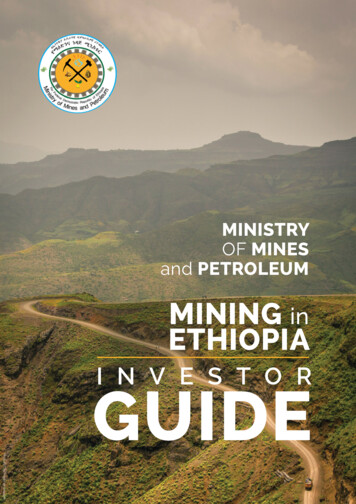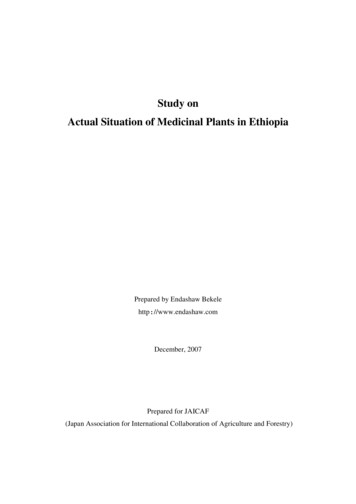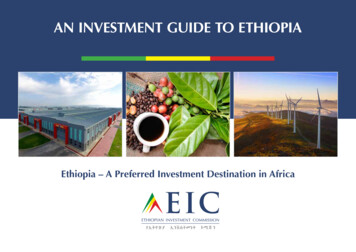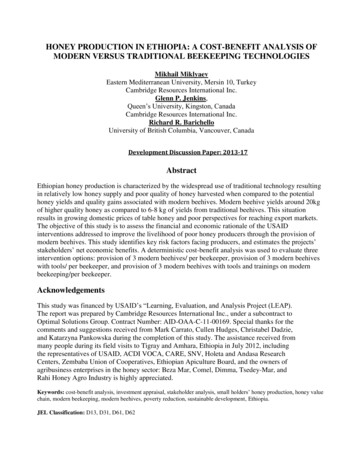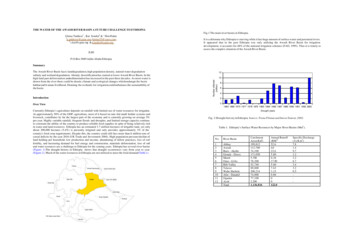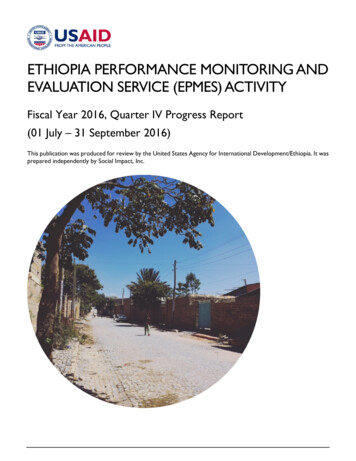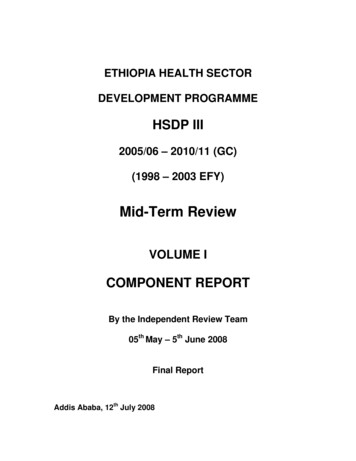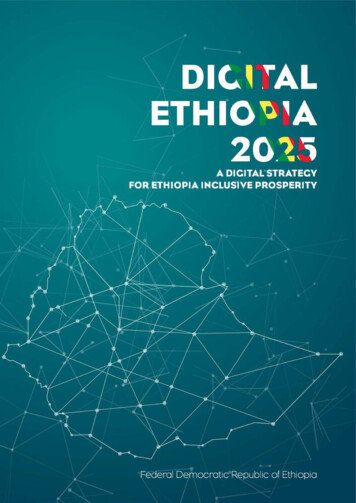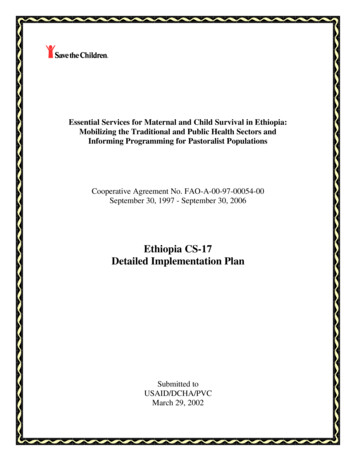
Transcription
Essential Services for Maternal and Child Survival in Ethiopia:Mobilizing the Traditional and Public Health Sectors andInforming Programming for Pastoralist PopulationsCooperative Agreement No. FAO-A-00-97-00054-00September 30, 1997 - September 30, 2006Ethiopia CS-17Detailed Implementation PlanSubmitted toUSAID/DCHA/PVCMarch 29, 2002
TABLE OF CONTENTSSECTION I:A.B.C.D.E.F.G.H.I.J.PROGRAM DESCRIPTIONExecutive Summary .9CSGP Data Form .11Description of the DIP Preparation Process .14Program Site Analysis .15Summary of Baseline and Other Assessments .23Program Approach .28Organizational Development .35Sustainability .45Behavior Change Strategies.49Quality Assurance .55SECTION II:A.B.C.D.E.F.G.H.I.J.PROGRAM MANAGEMENTManagement Approach .57Human Resources.59Contingency and Security Plan.64Technical Assistance Plan .65Information Management .66Financial Management .66Logistical Management .67Monitoring and Evaluation.68Budget .77Work Plan .77SECTION III:A.B.C.D.E.F.G.DETAILED PLANS BY INTERVENTIONIntegrated Management of Childhood Illness.83Immunization .85Control of Diarrheal Disease .88Pneumonia Case Management .89Control of Malaria.92Maternal and Newborn Care.93STI/HIV/AIDS Prevention .98SECTION IV:ANNEXES .101(Pages available only in hard copy are paginated alphabetically)1.2.3.4.5.6.7.8.Response to Final Evaluation Recommendations .102Report of Baseline Assessments .105Agreements .139Resumes/CVs of Key Personnel .142Proposed Evaluation Guidelines (not applicable)Response to Application Debriefing .146Maps, SC CS-17 Organizational Chart, CS-17 Forms.149Ethiopia IMCI Strategies, Schedules, & CDD Protocols .150Essential Services for Maternal and Child Survival in Ethiopia – CS-17 Detailed Implementation Plan1
DIP Tables and Charts (Excluding Annexes)Childhood Nutrition Status in Liben District, Oromiya Region,and Ethiopia, 1997-2000.20Institutional Strengths Assessment Final Prioritization Matrix .37CS-17 Summary Training Plan for the Five Year Life of the Project.42CS-17 Detailed Training Plan for Years One and Two.43CS-17 Summary Management Structure.57MOH and Community Volunteers: Estimated Percent Effort& Principal Roles in CS-17 .63CS-17 Goals, Results, Intermediate Results, and Selected End ofProgram Objectives .68CS-17 Capacity Building Results and Indicators.69CS-17 Results and Indicators Related to Use of Health Servicesand Health Practices .70CS-17 Results and Indicators Related to Uptake, Availability,Quality, and Knowledge .71CS-17 Health Information System: Roles and Data Flow.72CS-17 Community and Health Services Monitoring .73CS-17 Work Plan for the Five Year Life of the Project .78CS-17 Detailed Work Plan for the First Year of the Project .80CS-17 Detailed Work Plan for the Second Year of the Project.82Liben DHO Data on EPI Performance in Liben District, FY 2001 .86Number of PAs to be Covered by Immunization Strategy & Year.87Rate of Classification/Treatment of Pneumonia/Severe PneumoniaIn Children Under Age 5 by all MOH Facilities of Liben District .90Children 24 Months Recorded at Five Liben Health Facilities .91Model for Integration of Effective HIV/AIDS Prevention and Control .100Essential Services for Maternal and Child Survival in Ethiopia – CS-17 Detailed Implementation Plan2
Glossary of Acronyms and TermsAbba ollaFather of the encampmentACNMAmerican College of Nurse MidwivesAFPAcute Flaccid ParalysisANCAntenatal CareAIDSAcquired Immune Deficiency SyndromeARIAcute Respiratory InfectionBCBehavior ChangeBCCBehavior Change CommunicationBCGTuberculosis Vaccine (Bacillus Calmette-Guerin)BEOCBasic Emergency Obstetric CareBHR/FFPBureau of Humanitarian Response/Office of Food for Peace (of USAID, nowDCHA/FFP)BHR/PVCBureau of Humanitarian Response/Office of Private and Voluntary Cooperation(of USAID, now DCHA/PVC)BHTBridge-to-Health TeamBSSBehavioral Surveillance SurveyBussaWhen a person is force by the tribal leaders to take several women as wives, inaddition to existing wives.CACCommunity Action CommitteeCBDCommunity-Based DistributorCBOCommunity-Based OrganizationCBRHACommunity-Based Reproductive Health AgentCDCUS Centers for Disease Control and PreventionCDDControl of Diarrheal DiseaseCheresaWise Man/Male Traditional HealerCheretiWise Woman/Traditional Birth AttendantCHACommunity Health AgentCHWCommunity Health Worker (BHT & HAC members, TBAs, CMWs, CBDs)C-IMCICommunity-Integrated Management of Childhood IllnessCOOPICooperazione Internazionale (Italian NGO)CMCommunity MidwifeCMWCase Management Worker (CHW trained to do case management)Essential Services for Maternal and Child Survival in Ethiopia – CS-17 Detailed Implementation Plan3
CSChild SurvivalCS-13Child Survival-13, WomanWise, the previous CS project in Liben District,funded through the 13th cycle of the PVO CS Grants Program.CS-17The current child survival project in Liben District, Essential Services forMaternal and Child Survival in Ethiopia: Mobilizing the Traditional and PublicHealth Sectors and Informing Programming for Pastoralist Populations,funded as a cost extension of the CS-13 grant, mainly through the 17th cycle ofthe PVO CS Grants Program, is referred to as “CS-17” throughout thisdocument to distinguish it from the previous “CS-13” grant, and for the sake ofbrevity.CSTSChild Survival Technical Support Project (contractor to AID/DCHA/PVC)CSWCommercial Sex WorkerDACDistrict AIDS CouncilDAPDevelopment Assistance Program (current FFP-funded Liben Title II program)DCHA/FFPBureau for Democracy, Conflict, and Humanitarian Assistance/Office of Foodfor Peace (of USAID, formerly BHR/FFP)DCHA/PVCBureau for Democracy, Conflict, and Humanitarian Assistance/ Office ofPrivate and Voluntary Cooperation (of USAID, formerly BHR/PVC)DFOD-MSDeputy Field Office Director - Management ServicesDHACDistrict HIV/AIDS CouncilDhedaGroups of ollas that share grazing areasDHCCDistrict Health Coordination CommitteeDHMTDistrict Health Management TeamDHODistrict Health Office/OfficerDHSDemographic and Health SurveyDIPDetailed Implementation PlanDKTEthiopian affiliate of PSI (Population Services International)DPT/DPT3Diptheria/Pertussis/Tetanus Vaccine, and DPT third doseEFOEthiopia Field (Country) Office of Save the Children/USEFYEthiopia Fiscal YearEmOCEmergency Obstetric CareEPIExpanded Program for ImmunizationERCEthiopian Red CrossESHE IIEssential Services for Health in Ethiopia II (USAID Ethiopia Mission SO)ETDFEmergency Transport and Drug Fund(s)Essential Services for Maternal and Child Survival in Ethiopia – CS-17 Detailed Implementation Plan4
FFWFood-For-WorkFGAEFamily Guidance Association of EthiopiaFGDFocus Group DiscussionFHIFamily Health InternationalFOField OfficeFODField Office DirectorForraThe mobile part of a family and herd, which is composed of young men andolder boys who travel long distances with the strong male cattle in search ofpasture and water.FPFamily PlanningFTEFull-Time EquivalentFYFiscal YearGOEGovernment of EthiopiaGMPGrowth Monitoring and PromotionGTZThe German Agency for Technical CooperationHAHealth AssistantHACHealth Action CommitteeHB-LSSHome-Based Life-Saving SkillsHFHealth FacilityHFAHealth Facility AssessmentHFMCHealth Facility Management CommitteeHH/C-IMCIHousehold/Community Integrated Management of Childhood IllnessHISHealth Information SystemHIVHuman Immune Deficiency VirusHMISHealth Management Information SystemHPNHealth, Population, and NutritionHQHeadquartersHSDPHealth Services Development Program of the Government of EthiopiaIACIIntegrated Approaches to Childhood IllnessIECInformation, Education, CommunicationIMCIIntegrated Management of Childhood IllnessIMPACIntegrated Management of Pregnancy and ChildbirthEssential Services for Maternal and Child Survival in Ethiopia – CS-17 Detailed Implementation Plan5
ISAInstitutional Strengths AssessmentJalla/JalletuExtra-marital sexual partners, both for men and women.KafenoRefers to the sexual practices during the rainy season after plenty of milk hasbeen consumed.KatenaCommunity consisting of several villages, but smaller than a PAKebelePeasant Association, administrative divisionKPCKnowledge, Practice, and CoverageLAMLactational Amenorrhea MethodLOPLife of ProjectLSSLife-Saving Skills (maternal and newborn)MaddaTraditional community group, comprised of several “ollas” sharing the samewater point. Each madda corresponds roughly to one of Liben’s PAsM&EMonitoring and EvaluationMCHMaternal and Child HealthMCMMalaria Case ManagementMISManagement Information SystemsMMRMaternal Mortality Ratio/RateMNMaternal and NewbornMN/LSSMaternal and Newborn Life Saving SkillsMNCMaternal and Newborn CareMOHMinistry of HealthMTCTMaternal to Child TransmissionMTEMidterm EvaluationNCIHNational Council for International HealthNGONon-Governmental OrganizationNIDSNational Immunization DaysOCAOrganizational Capacity AssessmentOHOffice of Health (of Save the Children/US)OllaBorana term for extended family encampmentOPDOutpatient DepartmentORSOral Rehydration SolutionORTOral Rehydration TherapyEssential Services for Maternal and Child Survival in Ethiopia – CS-17 Detailed Implementation Plan6
PAPeasant Association (“kebele”), an administrative divisionPCMPneumonia Case ManagementPHNPopulation, Health, and NutritionPITProtective Intermittent TreatmentPLGProgram Learning GroupPLIPastoralist Livelihood InitiativePLWHAPeople Living With HIV/AIDSPMProgram ManagerPMTCTPreventing Mother to Child TransmissionPPSProbability Proportional to SizePVOPrivate Voluntary OrganizationQAQuality AssuranceRDFRevolving Drug FundRHReproductive HealthRHAReproductive Health Agent / Regional Health AdvisorRHBRegional Health Bureau (of the Ethiopian MOH)SCSave the Children Federation (USA)SC/EFOSave the Children/US Ethiopia Field (Country) OfficeSCMStandard Case ManagementSC/OHSave the Children’s Office of HealthSNLSaving Newborn Lives Initiative of Save the ChildrenSOStrategic ObjectiveSOSSustainable Outreach ServiceSPASenior Program Assistant (SC staff in Liben District)STISexually Transmitted Infection / Southern Tier Initiative (USAID/Ethiopia)TATechnical AssistanceTBTuberculosisTBATraditional Birth AttendantTOTTraining of TrainersTTTetanus ToxoidTT2Tetanus Toxoid, 2nd doseTTBATrained Traditional Birth AttendantEssential Services for Maternal and Child Survival in Ethiopia – CS-17 Detailed Implementation Plan7
UNAIDSUnited Nations Program on HIV/AIDSUNFPAUnited Nations Fund for Population ActivitiesUNICEFUnited Nations Children’s FundUSAIDUnited States Agency for International DevelopmentVCTVoluntary Counseling and TestingWaaqeefattaTraditional followers of one GodWarraThe stationary part of the family consists of women and children who take careof the milking cows, weak or sick cows and calves at the olla.WHOWorld Health OrganizationWoredaDistrictWRMCWater Resource Management CommitteeZHDZonal Health DepartmentEssential Services for Maternal and Child Survival in Ethiopia – CS-17 Detailed Implementation Plan8
SECTION I:A.PROGRAM DESCRIPTIONExecutive SummaryThe site for this five year Child Survival-17 program, Essential Services for Maternal and ChildSurvival in Ethiopia: Mobilizing the Traditional and Public Health Sectors and InformingProgramming for Pastoralist Populations, includes all of Liben District in Borana Zone ofOromiya Regional State in southern Ethiopia. The district has a total estimated currentpopulation of 138,000, with approximately 58,000 program beneficiaries, of which 26,000 arechildren under five years of age, and 32,000 are women between the ages of 15 and 49.Woefully poor access to essential health services contributes to poor maternal and child health inLiben. In August 2000, SC found 34% of sampled 6-59 month-old children in the districtunderweight, 11% wasted, and 42% stunted. These high rates of childhood malnutrition, localtransmission of falciparum malaria, and socio-economic conditions in Liben, all suggest the levelof under-five mortality in the district is likely similar to that for Ethiopia as a whole, estimated at166 deaths per 1,000 live births for 1995-99 by the 2000 DHS. Very poor access to essentialobstetric care and low contraceptive prevalence also suggests that maternal mortality in thedistrict is likely very high. During recent months, the blood of 48% of apparently healthy donorsat Negelle Hospital in the district center has been screened HIV-positive, and HIV prevalence inthe district is likely high.Save the Children (SC) has been supporting two complementary programs throughout Libensince 1997, the CS project (CS-13 through September 2001, followed by CS-17), and aUSAID/DCHA/FFP-funded DAP, which currently supports nutrition and breastfeedinginterventions in district, along with other development activities, including improving livestockmanagement. Health promotion through 150 “Bridge-to-Health Teams” (BHTs), each composedof a wise woman/TBA, a wise man/male traditional healer, and a young traditional apprentice,has been the central strategy of SC’s health activities in Liben. Health Action Committees(HACs) review and respond to health information from BHTs and TBAs. In April 2000, theAmerican College of Nurse Midwives started providing on-going assistance to improve obstetriccare at community and health facility levels by training TBAs and health facility staff in LifeSaving Skills.The CS-17 design is the result of joint planning by staff of the principal program partners, SCand the Liben District Health Office (DHO), during two workshops conducted in Negelle inSeptember 2000 and in February 2002. CS-17 will support six interventions:§§§§§§Maternal and newborn care (at 20% of planned intervention-specific effort);Pneumonia case management (15%);Control of malaria (10%); andControl of diarrheal disease (10%), all previously implemented through CS-13;Immunization (15%), funded until recently through the DAP; and introduce anHIV/AIDS intervention (30%).These CS-17 interventions will be implemented through the following major strategies:§Joint DHO/SC design, implementation, and evaluation of approaches to maternal and childhealth in Liben that inform development of strategies to address the needs of pastoralistpopulations in other districts of Borana Zone and Ethiopia.Essential Services for Maternal and Child Survival in Ethiopia – CS-17 Detailed Implementation Plan9
§Continued mobilization of community leaders and traditional practitioners through Bridgeto-Health Teams and Health Action Committees, to support selected MCH services, and toconduct focused education to improve key emphasis behaviors at the household level.§Introduction and evaluation of community-based case management of childhood illness, toimprove access to and use of these services in Liben District, and to inform the nascentdevelopment of Community-IMCI in Ethiopia.§Building capacity of SC, the DHO, and the District HIV/AIDS Council, to provideleadership, coordination, and technical advice for integration of effective HIV prevention,care and support, and mitigation efforts into ongoing community and government activitiesin Liben District.CS-17 goals are:§§A sustained reduction in under-five and maternal mortality in Liben District, and;CS-17 approaches inform policy or programming for pastoralist areas of Ethiopia inCommunity-IMCI or reproductive health.These goals will be achieved through CS-17 results of:§§§§Improved district capacity to effectively support community health services and activities;Improved community capacity to effectively address priority health needs of mothers andchildren under five;Increased use of key health services and improved MCH practices at household level, and;Adoption of CS-17 approach by the MOH or by other organizations in Ethiopia.These results will be achieved through CS-17 intermediate results of:§§§§§Increased availability of selected MCH services in Liben;Documented quality of select community MCH services;Increased maternal knowledge in Liben of selected MCH issues;Dissemination of feasibility and results of implementing innovative CS-17 approaches, and;Increased SC/Addis and SC/Liben capacity in behavior change and integrated HIVprogramming.The Ethiopia CS-17 Program is funded from September 30, 2001 through September 30, 2006 asa cost extension of CS-13 grant with 1,250,000 from USAID/DCHA/PVC, matched by a 416,750 cost-share from Save the Children.SC has discussed the CS-17 design with several members of the staff of the USAID Mission inAddis Ababa, including Ms. Vathani Amirthanayagam, PHN Chief, Dr. Hana Nekatebeb and Mr.Eshete Yilma, Project Management Specialists, and Ms. Janet Paz-Castillo, Project DevelopmentOfficer. Although Dr. Hana and Ms. Paz-Castillo have been redeployed to other positions andMissions, respectively, SC has maintained continuous dialogue with Dr. Mary Ann AbeytaBehnke and Anne Nolan – the new HPN Health Team at USAID.Principal authors of this DIP are: Ms. Ashley Aakesson, International Hunger Fellow, SC/Liben;Dr. Tedbabe Degefie, Health Advisor, SC/Addis Ababa; Mr. Worku Tefera, CS-17 TrainingCoordinator, SC/Liben; Mr. Dennis Walto, Deputy Field Office Director for Programs, SC/AddisAbaba; Ms. Kedija Zeino, SC HIV/AIDS Consultant; and, Dr. Eric S. Starbuck, Child SurvivalSpecialist (and contact person for CS-17 at SC in Westport, CT, along with Ms. Carmen Weder,Manager, Office of Health). Most other participants of the February 2002 CS-17 DIP workshopin Negelle also made substantial contributions to the DIP.Essential Services for Maternal and Child Survival in Ethiopia – CS-17 Detailed Implementation Plan10
B.CSGP Data FormField Contact InformationFirst Name:Dr. TedbabeLast Name:DegefieAddress:Save the Children/USAPO Box 387City:Addis roject InformationProjectDescription:SC and the MOH Liben District Health Office will continue implementationthrough CS-17 of all four CS-13 interventions: ARI (at 15% of plannedintervention-specific CS-17 effort), Malaria (10%), CDD (10%), and Maternaland Newborn Care (20%); and continue important support to the DHO in EPI(15%), previously funded through the DAP. CS-17 will devote 30% ofintervention effort to introducing an HIV/AIDS intervention, in order to buildSC and DHO capacity in Liben to begin addressing the district’s HIV epidemic.These CS-17 interventions will be implemented through the following majorstrategies:· Joint DHO/SC design, implementation, and evaluation of approaches tomaternal and child health in Liben that inform development of strategies toaddress the needs of pastoralist populations in other districts of Borana Zone andEthiopia.· Introduction and evaluation of community-based case management ofchildhood illness, to improve access to and use of these services in LibenDistrict, and to inform the nascent development of Community-IMCI inEthiopia.· Building capacity of SC, the DHO, and the District HIV/AIDS Council, toprovide leadership, coordination, and technical advice for integration of effectiveHIV prevention, care and support, and mitigation efforts into ongoingcommunity and government activities in Liben District.· Continued mobilization of community leaders and traditional practitionersthrough Bridge-to-Health Teams and Health Action Committees, to supportselected MCH services, and to conduct focused education to improve keyemphasis behaviors at the household level.Partners:MOH Liben District Health OfficeEssential Services for Maternal and Child Survival in Ethiopia – CS-17 Detailed Implementation Plan11
ProjectLocation:The CS-17 site includes all of Liben District in Borana Zone of OromiyaRegional State in southern Ethiopia.Grant Funding InformationUSAID Funding: (US ) 1,250,000 PVO match:(US ) 416,750Target BeneficiariesTypeInfants (0-11 months):0-59 month old children:Women 15-49:Estimated Number of Births:Beneficiary 06,400Rural75%General Strategies Planned§ Advocacy on Health Policy§ Strengthen Decentralized Health System§ Information System TechnologiesM&E Assessment Strategies§ KPC Survey§ Organizational Capacity Assessment with Local Partners§ Organizational Capacity Assessment for your own PVO§ Community-based Monitoring Techniques§ Participatory Evaluation Techniques (for mid-term or final evaluation)Behavior Change & Communication (BCC) Strategies§ Interpersonal Communication§ Peer CommunicationCapacity Building Targets PlannedPVONon-Govt PartnersField Office, HQ (None Selected)CS Project TeamOther PrivateSectorGovtTraditional Healers Dist. Health SystemHealth Facility StaffCommunityHealth CBOsCHWsEssential Services for Maternal and Child Survival in Ethiopia – CS-17 Detailed Implementation Plan12
InterventionsImmunization 15%** CHW Training** HF Training*** Polio*** Classic 6 Vaccines*** Vitamin A*** Cold Chain StrengtheningAcute Respiratory Infection 15%** IMCI Integration** CHW Training** HF Training*** Pneumonia Case Management*** Case Mngmnt./Counseling*** Access to Providers/Antibiotics*** Recognition of ARI Danger SignsControl of Diarrheal Diseases 10%** IMCI Integration** CHW Training** HF Training*** Hand Washing*** ORS/Home Fluids*** Feeding/Breastfeeding*** Care Seeking*** Case Mngmnt./CounselingMalaria 10%** IMCI Integration** CHW Training** HF Training*** Training in Malaria CM*** Adequate Supply of Malarial Drug*** Access to providers and drugs*** Care Seeking, Recognition, ComplianceEssential Services for Maternal and Child Survival in Ethiopia – CS-17 Detailed Implementation Plan13
Maternal & Newborn Care 20%** CHW Training** HF Training*** Emergency Obstetrical Care*** Recognition of Danger signs*** Newborn Care*** Postpartum Care*** Normal Delivery Care*** Birth PlansHIV/AIDS 30%** CHW Training** HF Training*** Treatment of STIs*** Behavior Change Strategy*** Access/Use of CondomsC.Description of the DIP Planning and Preparation ProcessA CS-171 planning workshop was conducted in Negelle from February 6 to 17, 2002, attendedby staff of local partners, SC’s Home Office, Ethiopia Field Office staff, and staff involved inproject implementation. The workshop started by identifying important developments since theinitial CS-17 design workshop in September 2000 and submission of the grant application inDecember 2000, and challenges for CS-17 implementation, and an assessment of how thesedevelopments should influence a revised CS-17 design to be described in the DIP. The processwas participatory in approach with active involvement of partners, and included severalpresentations and discussions regarding HIV/AIDS in relation to CS-17, and alternativestrategies for EPI, including WHO’s approach to “Sustainable Outreach Services” for EPI.2Developments since the September 2000 workshop with potential implications for the CS-17design include: The new government restructuring, which will bring decision-making andplanning responsibility to the District Council, the strategic framework for HIV/AIDS,3 the CS13 final evaluation, and change in staff both in SC and the DHO. Following initial discussions inplenary, participants divided into small groups to work on intervention designs, strategies, and1The current child survival project in Liben District, Essential Services for Maternal and Child Survivalin Ethiopia: Mobilizing the Traditional and Public Health Sectors and Informing Programming forPastoralist Populations, funded mainly through the 17th cycle of the PVO CS Grants Program, is referredto as “CS-17” throughout this document to distinguish it from the previous “CS-13” grant, and for thesake of brevity.2WHO presentation by Hans Everts on “The Future of EPI,” created June 1999.3Strategic Framework for the National Response to HIV/AIDS in Ethiopia (2001-2005), NationalHIV/AIDS Council, June 2001.Essential Services for Maternal and Child Survival in Ethiopia – CS-17 Detailed Implementation Plan14
cross-cutting issues, before presenting their work to the large group for discussion and decisions.After the end of the workshop, many of the participants continued to work in Negelle, AddisAbaba, and in Westport on sections of the DIP, communicating with each other by e-mail,phone, and courier. Workshop participants included:§Sister Degefech H/Yesus,SC/LibenMCH/Nurse§Mr. Worku TeferaSC/LibenTraining Coordinator§Mr. Tsegaye SontoSC/LibenHealth Project Coordinator§Mr. Gebre TolaSC/LibenEPI Unit Head§Sister Melkenesh KetemaSC/LibenFP Unit Head§Sister Zubeda Abdul KadirSC/LibenNutrition Educator§Mr. Tefera JalataSC/LibenNutritionist§Mr. Mohammed MamuSC/LibenHIV/AIDS Unit Head§Ms. Ashley AakessonSC/LibenInternational Hunger Fellow§Mr. Abrahma BongassieSC/LibenProgram Manager§Dr. Tedbabe DegefiSC/Addis AbabaHealth Advisor§Dr. Eric S. StarbuckSC/WestportChild Survival Specialist§Dr. Taye ToleraDHO, Negelle, andNegelle HospitalDistrict Health Office Head,and Medical Director§Dr. Abera RefissaZonal Health Dep., NegelleZHD Head§Ms. Kedija ZeinoAddis AbabaSC HIV/AIDS ConsultantD.Program Site AnalysisEthiopiaOver the past three decades, Ethiopia has experienced major conflict and natural disasters withsevere socioeconomic consequences. Challenges to improving health at the household andinstitutional level in Ethiopia are formidable. An immense country with a population of 65million, it is the second most populous nation in sub-Saharan Africa. Per capita income is 110per year and agriculture production is less than it was 25 years ago. Population growth is high, at2.7% per year,4 and exceeds the growth in agricultural production.5 Ethiopia is one of the mostfood insecure countries in the world. It is estimated that even under normal conditions 6.841990 – 1999. The State of the World’s Children 2001. UNICEF, 2000.5Agriculture production grows on average at an annual pace of 2.4%.Essential Services for Maternal and Child Survival in Ethiopia – CS-17 Detailed Implementation Plan15
million people are without the wherewithal to feed themselves throughout an entire year.6 Totaladult literacy is 36%. Female literacy is estimated at 54% of male literacy. 7Ethiopia has some of the world’s poorest health statistics and lags behind most of sub-SaharanAfrica. Life expectancy is 44 years at birth.8 UNAIDS puts Ethiopia’s current HIV prevalenceat 10.6%,9 meaning some three million adults and children were living with HIV/AIDS at theend of 1999, the third largest population of HIV-infected persons in the world.The Ethiopia 2000 Demographic and Health Survey (DHS) reports a total fertility rate of 5.9 forthe country as a whole in 1995 to 1999.10 The DHS direct estimate of maternal mortality of 871per 100,000 live births for 1994-1999,11 is lower than a recent WHO/UNICEF/UNFPA modelbased estimate of 1,800 for 1995 (yielding a one in seven lifetime risk of maternal death), butjust within the model-based estimated MMR range of 790 to 3,200.12 Most information on thecauses of maternal death in Ethiopia is from hospital-based studies likely to be unrepresentativeof maternal deaths in communities,13 though a community-based study conducted in the AddisAbaba area in 1983 found septic abortion to be the leading cause of death, followed byhemorrhage, and hypertensive diseases.14The United Nations estimates that Ethiopia’s under-five mortality in 1999 was 176 deaths per1,000 live births,15 the Ethiopian Ministry of Health estimates it at 161 for 1996-2001,16 while6A recent Food and Agricultural Or
Detailed Implementation Plan Submitted to USAID/DCHA/PVC March 29, 2002 . G. STI/HIV/AIDS Prevention.98 SECTION IV: ANNEXES .101 (Pages available only in hard copy are paginated alphabetically) . CS-17 Detailed Implementation Plan 5 FFW FGAE FGD FHI FO FOD Forra FP FTE FY GOE GMP GTZ HA HAC HB-LSS HF HFA HFMC HH/C-IMCI HIS HIV HMIS .
